As the world celebrates the going of 2018 and the coming of 2019, a part of us yearns to look back in time, while another drives us to look ahead. Standing at yet another cusp of time, one has the option to do either, neither or both. We chose to do both and went on an enchanting journey that has magic and intrigue.
Looking ahead
If astrological predictions are any indication, 2019 promises some major stories of the decade to unfold as several things hanging in the balance today are likely to reach denouement. On the political front, the world’s largest democracy, India, is due to go to polls in the year. The results of parliamentary polls have never been so uncertain in a long while.

To the west, Great Britain is teetering on the brink of an exit from the European Union, which may finally materialise. Brexit will determine how the new world will move forward.
Further West, US President Donald Trump could face an impeachment as was being predicted way back when he was elected to power. With the shutdown in the US over Trump’s demand for funds to raise a wall on the Mexican border, the US president appears to be hurtling towards such an end.
For cricket lovers, 2019 is another year when titans of the game clash in the UK, and if astrologers are to be believed, this edition will produce an unpredictable winner. There are numerous other events lined up across segments in 2019.
Years of years
Every year as the New Year’s Day is celebrated world over, one thing that is not remembered is that it is a new year by but one measure of time that is used as a marker on a continuum of time like a line drawn on water. The world has numerous such measures keeping track of time.
The Julian Calendar took effect in 46 BC, and New Year’s Day was celebrated January 1 for the first time in history. Shortly before his assassination in 44 BC, Julius Caesar had changed the name of the month Quintilis to Julius (July) after himself. Later, the month of Sextilis was renamed Augustus (August) after his successor.
In 1582, the Gregorian calendar was brought into effect, omitting 10 days for that year and establishing the new rule that only one of every four centennial years should be a leap year. Since then, people around the world have gathered en masse January 1 to celebrate the precise arrival of the New Year.
In India, there are New Years for every region based on different calendars. In states such as Assam, Bengal, Kerala, Nepal, Odisha, Punjab, Telangana, Andhra Pradesh and Tamil Nadu people celebrate New Year when the Sun enters Aries in the Hindu calendar. This is normally April 14 or 15, depending on the leap year. Elsewhere in northern/central India, the Vikram Samvat calendar is followed. According to the calendar, New Year’s day is the first day of the Chaitra, also known as Chaitra Shukla Pratipada or Gudi Padwa. This basically is the first month of the Hindu calendar, the first shukla paksha (fortnight) and the first day and normally comes around March 23–24, mostly around the Spring Equinox in Gregorian calendar. New Year is celebrated by paying respects to elders in the family and by seeking their blessings.
In Odisha, New Year is celebrated on Pana Sankranti, also known as Maha Bishuba Sankranti, which falls on April 14 every year according to the Gregorian calendar. The festival date is in tune with the solar cycle of the lunisolar calendar, as the first day of the traditional solar month of Mesha (Aries).
The New Year in Kerala (Puthuvarsham in Malayalam) is celebrated either on the first day of the month of Medam, which begins mid-April (known as Vishu) or on the first day of the month Chingam, in the Malayalam Calendar in mid-August according to another reckoning.
The Sikhs, in turn, celebrate New Year in accordance with the Nanakshahi calendar. The calendar has been set in tune with the birth of the first Sikh Guru, Guru Nanak in 1469. The first day of this calendar falls on March 14 in the Gregorian calendar.
Telugu New Year (Ugadi) and Kannada New Year (Yugadi) are celebrated in generally in March and occasionally in April. Traditionally, it is celebrated as Chaitram Chaitra Shuddha Padyami in parts of Andhra Pradesh, Telangana and Karnataka to mark the event of New Year’s Day for the people of the Deccan region of India.
Diwali is related to New Year’s celebrations for the Marwari community according to the Gujarati calendar. The Nepal Sambat, the New Year celebration of Nepal also coincides with Diwali.
The Chinese New Year, known as Spring Festival, is celebrated in many countries around the world. It is the first day of the lunar calendar and is corrected with the solar calendar every three years. The holiday normally falls between January 20 and February 20 and is celebrated with food, family get-togethers, lucky money (usually in a red envelope), and many other red things for good luck.
Lion and dragon dances, drums, fireworks, firecrackers, and other types of entertainment that fill the streets of China on this day. 2019 is to be the year of pig, a symbol of personality and good fortune, in China.
The Vietnamese New Year also falls between January 20 and February 20. This year marks the arrival of spring, based on the Chinese calendar, a lunisolar calendar.
The Korean New Year is celebrated in tune with the Gregorian calendar. It is a national holiday in Korea and people get a day off, while they have a minimum of three days off on Lunar New Year. Koreans celebrate New Year’s Day by preparing food for their ancestors’ spirits, visiting ancestors’ graves, and playing Korean games.
Cambodian New Year (Chaul Chnam Thmey) is celebrated April 13 or April 14. During these periods, Cambodians visit pagodas or play traditional games.
Thai New Year is celebrated April 13 or April 14 and is called Songkran in the local language. People usually come out to splash water on one another. The throwing of water originated as a blessing. By capturing the water after it had been poured over the Buddhas for cleansing, this “blessed” water is gently poured on the shoulder of elders and family for good fortune.
The Sinhalese New Year (aluth avurudda), marks the end of harvest season, by the month of Bak (April) between April 13 and April 14. There is an astrologically generated time gap between the passing year and the New Year, which is based on the passing of the sun from the Meena Rashiya (House of Pisces) to the Mesha Rashiya (House of Aries) in the celestial sphere.
Serbian New Year is celebrated January 14. The Serbian Orthodox Church, with traditional adherence in Serbia (including Kosovo), Bosnia and Herzegovina, Montenegro and Croatia, celebrates its feasts and holidays according to the Julian calendar.
Hijri New Year in Islamic culture is also known as Islamic New Year. It marks the beginning of Islamic calendar year. The Islamic New Year changes from year to Gregorian calendar year as the Islamic calendar is a lunar calendar. The first day of the year is observed on the first day of Muharram, the first month in the Islamic calendar.
The Persian New Year marks the first day of spring and the beginning of the year in the Iranian calendar. It is celebrated on vernal equinox, which usually occurs March 21 or the previous or following day depending on where it is observed.
What stars tell
According to astrologers, the same planets that would influence these events and the fate of nations and world leaders, would also have an effect on the lives of ordinary mortals in 2019. Somnath Swain, a known astrologer from the state, says the extraordinary speed with which Jupiter would move from Scorpio to Sagittarius and then back within a few weeks would change the fate of the world in the first six months of 2019. It can result in events and circumstances that cannot be imagined today, he says.
The transit of Rahu and Ketu from Cancer to Gemini in March will also bring sudden, unplanned and unforeseen changes. Usually the movement of Rahu and Ketu shifts the axis on which the world is turning. This is what one should expect to take place according to the Vedic horoscope predictions in 2019.
Pramod Kumar Panda, another astrologer of fame, predicts that the alignment of planets indicates the possibility of strained relations between the ruler and subjects in 2019. However, India will see economic growth and improving bilateral relationship with neighbour. He didn’t rule out a mass armed conflict globally.
However, Swain was of the opinion that these events will not affect the world if people recognise the devil inside. A good decision-making capacity and the ability to avoid unnecessary hysteria are key to overcome any situation, he added.
THROUGH PARALLELS OF TIME
THE JALLIANWALA BAGH MASSACRE: A hundred years ago, April 13, British Indian Army troops under the command of Colonel Reginald Dyer marched into the Jallianwala Bagh in Amritsar. They took position around a peaceful gathering at the park and under Dyer’s orders emptied their rifles at the unarmed masses who got trapped within the confines of the fortified park, were hit by bullets and died. Over a 1,000 Indians died in what came to be known later as the Amritsar Massacre. The coming year marks a century since.
THE TREATY OF VERSAILLES: If India witnessed a bloody April in 1919 with the incident at Jallianwala Bagh, the world witnessed a conclusive end to hostilities of the First World War with the signing of the Treaty of Versailles a couple of months later. The treaty, which ended the state of war between Germany and the Allied Powers, was signed on June 28, 1919, at Versailles, exactly five years after the assassination of Archduke Franz Ferdinand which directly led to World War I.
INDEPENDENT AFGHANISTAN: On August 19, 1919, Afghanistan gained independence from the United Kingdom. The country that global powers such as Russia and the US have tried in vain to tame has remained independent since barring for crises brought upon it by religious hardliners and economic backwardness.
CUTTACK CONNECTED: The Bengal-Nagpur Railways connected Cuttack with Madras (Chennai) and Calcutta (Kolkata) in 1919. The Bengal Nagpur Railway was a company that pioneered development of railways in eastern and central India. It was succeeded first by Eastern Railway and subsequently by South Eastern Railway.
SAMAJ IS BORN: Gopabandhu Das, known as the Gandhi of Odisha, started ‘The Samaj’, one of the oldest newspapers of India as a weekly from Satyabadi, Puri district to revive Odia language and to facilitate the freedom struggle in 1919.
EVENTS CALENDAR
# Sundance Film Festival: January 24 to February 3
# Berlin Film Festival: February 7 to 17
# The Lantern Festival in Taiwan: February 19
# Salvador de Bahia Carnival: February 28 to March 6
# Rio Carnival: March 2 to 9
# Spring Dance Festival: April 18- 23
# Cannes Film Festival May 15 to 23
# Chelsea Flower Show: May 21 to 29
# Summer Dance Fest: July 3- 8
# Xmas Fest and Dance Festival: Dec 5 to 10
SPORTS CALENDAR
# Australia Open Tennis: Jan 14-27
# Special Olympics World Summer Games: Mar 14-21 Abu Dhabi, United Arab Emirates
# French Open Tennis: May 26-June 9
# World Cup Cricket: England
# Football (Soccer) Women’s World Cup: Jun 7 – Jul 7 France
# Wimbledon: Jul 1-14
# World Aquatics Championships: Jul 12-28 Gwangju, South Korea
# Indian Ocean Island Games: Jul 19-28 Port Louis, Mauritius
# US Open: Aug 26–Sep 9
# IWF World Championships: Sept 16-25, Pattaya, Thailand
# Davis Cup: Nov 18-24 Madrid or Lille






































